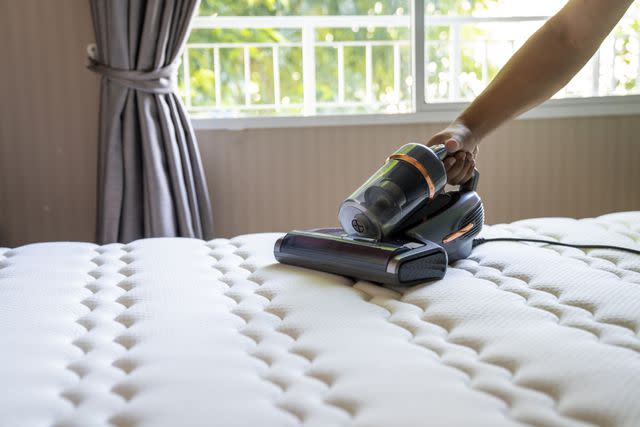Why You Should Clean Your Mattress–And The Proper Way To Do It
Turns out you should replace your mattress sooner than you think, but you should be cleaning it too.
You know pillows get dirty, and we've been told our washing machine is filthy, but what about our mattress? How often should it be cleaned and how does one go about cleaning it? We're breaking it all down starting with how to deep clean a mattress (both pillow top and foam), plus when to know if your mattress needs to be replaced. Let's tackle this dreaded chore together.

Getty/Witthaya Prasongsin
How To Deep Clean A Mattress
Start by taking off the mattress pad, foam, and/or covers. Consult each product's care instructions and clean accordingly. Using a handheld vacuum or canister vacuum with an upholstery attachment, vacuum the mattress to remove any pet hair, dust, or dirt.
Pillow Top Mattresses
The next step in your deep clean involves spot-treating stains. If you have a pillow top mattress, Consumer Reports suggests pet odor remover or carpet cleaner. Once stains have been lifted, sprinkle baking soda over the entire mattress. The pros at CR advise letting it sit for 24 hours so it can really work its deodorizing magic. That being said, if you don't have a guest room and aren't planning a night away, your friends here at Southern Living think that 12 hours should be just fine. Vacuum up the baking soda before making the bed with your clean linens, mattress pad, and/or cover. (You might think it goes without saying—but you'd be surprised.)
Memory Foam Mattresses
If you have a memory foam mattress, Chirofoam recommends this formula for a milder solution than prescribed above: ½ cup of fabric cleaner or white vinegar to 1 cup of water. Use the spray sparingly as memory foam will soak up liquid quickly and it's best not to saturate more layers than necessary. Once the spot is removed, wipe away any leftover solution with a wet cloth. Now is the time to crank up your overhead fan to full speed. You'll want the mattress completely dry as quickly as possible. A blow dryer will work in a pinch, but only on the cool setting. Heat could cause your mattress to become misshapen. Follow the spot cleaning with the same baking-soda process we outlined above. It's important to note that some memory foam mattresses require professional cleaning. Consult your care label.
Related: This Is How Often You Should Flip Or Rotate Your Mattress, According To Experts
How To Protect Your Mattress
Protecting your mattress starts with prevention. The most obvious way to do so is by selecting a mattress protector. A few of the top mattress protectors on Amazon are designed to provide a waterproof barrier, cut down on allergens, or added extra comfort. Pinpoint your needs to narrow down the best option for your mattress. A mattress protector won't do all the work for you, though. In order to get the most life out of your mattress, you'll need to keep up with a cleaning schedule. Completing the process outlined above anywhere from monthly to bi-annually is a good rule of thumb. Of course, your sheets should be cleaned weekly.
For more Southern Living news, make sure to sign up for our newsletter!
Read the original article on Southern Living.

